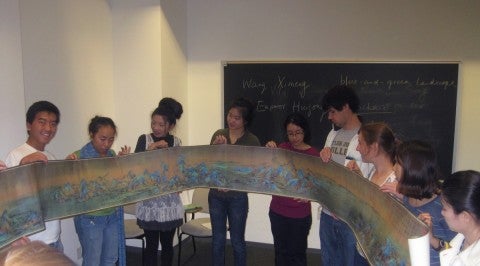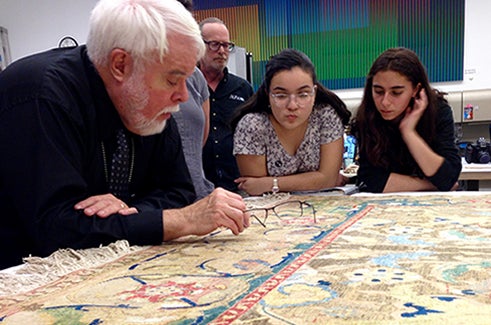Students in Dr. Aimée Froom’s Introduction to Islamic art course leaped from the classroom to the conservation laboratory at the Museum of Fine Arts, Houston, where they had a unique opportunity to examine the world of Islamic textiles. Dr. Walter B. Denny, University Distinguished Professor of Islamic Art at the University of Massachusetts-Amherst, led the session, which was designed exclusively for Rice students to gain first-hand experience with the arts of the loom in the MFAH’s collection of art from the Islamic worlds.
Students encountered various techniques used in textile production, such as embroidery and brocade. How did artists come up with their designs and how were they translated into woven realities? Dr. Denny explained that knot plans and cartoons were some of the devices weavers used to produce complex designs in cotton, linen, wool, and silk.
Students followed closely behind Dr. Denny as he surveyed over a dozen textiles and carpets in the lab. What are the materials? How do we distinguish the top of a carpet from the bottom? Such intimate access to the carpets and textiles, which is typically restricted to curators and conservators, allowed students to examine warp and weft construction and silk, cotton, and metal-wrapped threads with an electronic microscope connected to a laptop (top). Working on a large preparator’s table, Dr. Denny demonstrated how to properly measure the ratio of knots on a Polonaise carpet, which was over 13 feet in length and 5 feet wide (bottom).
After a forensic analysis of the carpet, students considered how such a large carpet was used. Surprisingly, the striking Polonaise carpet was not designed to be walked upon by Safavid consumers. Instead, carpets, including the magnificent Polonaise, were used widely by the Safavid court in the early 17th century for export to Poland and elsewhere in Europe to help maintain crucial political alliances against the powerful Ottoman Empire. Dr. Denny underscored the importance of carpets and textiles as diplomatic gifts and in trade across the Middle East and Europe.
(photos courtesy of Kyle G. Sweeney)



